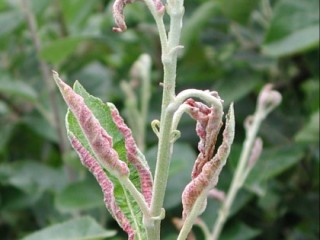
Apple leaf midge is a widespread and abundant but usually minor pest of apple present in all apple orchards, often on most trees. Apple and Malus sp. only are infested. All apple varieties are susceptible. Trees with vigorously growing shoots are attacked most heavily. A similar species, the pear leaf midge, attacks pear.
Leaf midge attacks young leaves, mainly in growing points, but can also attack rosette leaves. Larvae cause the edges of leaves to roll tightly round themselves to form characteristic leaf curls. Shoot growth is reduced. This is usually of little consequence in established orchards but is more important on nursery stocks and newly planted trees.
Occasionally, very severe attacks occur in established orchards, notably Bramley. Photosynthetic leaf area is greatly reduced, sometimes by over 50%, and this adversely affects fruit size and fruit bud formation.
The lifecycle involves 3-4 generations per year, the first around blossom time but the larval stage is the most readily recognised. Eggs are brown and cigar shaped and laid amongst hairs in the very tiniest leaves in the growing points. They can just be seen with the naked eye but use of a hand lens is desirable.
Numbers of eggs should be monitored weekly in a representative orchard on the farm if the pest is to be managed either with insecticides (i.e. on nursery stocks) or by control by its natural enemy, the parasitic wasp Platygaster demades in orchards.
The female-produced sex pheromone of apple leaf midge has been identified by East Malling Research and the Natural Resources Institute and is highly attractive to apple leaf midge males.
Sex pheromone traps are available from East Malling Research. The traps should be deployed in nurseries (or plantations where chemical control of leaf midge is to be applied) in early spring at the green cluster growth stage and monitored weekly through the season.
- The height of trap deployment is critical and a standard height of deployment of 0.5m is recommended. The lures last a season in the field.
- Unused lures should be stored in a freezer where they will remain viable for many years, or alternatively in a fridge where they will last 3 years or more.
- A nominal threshold of 30 midges per trap per week is proposed for timing sprays of insecticide (e.g. a synthetic pyrethroid in the UK).
A series of sprays at 7 day intervals is likely to be required. Good control of the first generation should result in a reduced attack in the later generations.
- The full approval for spirotetramat (Batavia) on apples for the control of sucking insect pests offers some control of apple leaf midge. Growers may prefer to reserve its use for difficult to control aphid species such as woolly aphid and rosy apple aphid. It must be applied after flowering and works best when pests are moving from brown wood to green tissue. It will prevent population build-up but does not offer pest ‘knockdown’.
- Synthetic pyrethroids such as deltamethrin (Decis Forte) offer incidental control when used to control other apple pests, if targeted against adults and eggs as they hatch. They are ineffective when used against larvae in leaf curls. However, their use should be avoided except possibly on nursery stock, as they are harmful to the predatory mite Typhlodromus pyri and to the parasitic wasp Platygaster demades, which is the key natural enemy of this pest (see below) and will do more harm than good in the long run.
- The bioinsecticide fatty acids (Flipper) has an EAMU approval for use on apples (3419/19). It is effective at controlling sucking insect pests such as aphids, whitefly and mites, so is likely to offer incidental control of leaf midge when applied for other pests. It is known to complement the use of Batavia as it provides quick ‘knockdown’. Its safety to beneficial insects such as Typhlodromus pyri and the parasitic wasp Platygaster demades (see below) is unknown, but it is generally safe to many other predators and parasitoids, so is considered to be more sutable to IPDM programmes than the synthetic pyrethroids.
The parasitic wasp Platygaster demades is the key natural enemy of apple leaf midge and will reduce populations to low, tolerable levels if allowed to establish and thrive. The parasite occurs naturally in the UK but is often absent or present at only very low levels in commercial orchards as it is sensitive to broad-spectrum insecticides.
- It can be introduced on infested leaves from other orchards if necessary. The parasite lays its eggs in the eggs of the apple leaf midge.
- The adult parasite is synchronised with its host but is vulnerable to insecticides including to residues on leaf surfaces.
- To foster the parasite, the use of broad-spectrum insecticides should be avoided during the egg-laying period of the leaf midge. More selective insecticides such as Bacillus thuringiensis, are less likely to be harmful to the parasite and these insecticides should be used for pest control at critical times if possible.
Control in organic orchards
Emphasis should be placed on cultural and biological control methods as there are no known effective chemical control methods for leaf midge in organic apple production.
